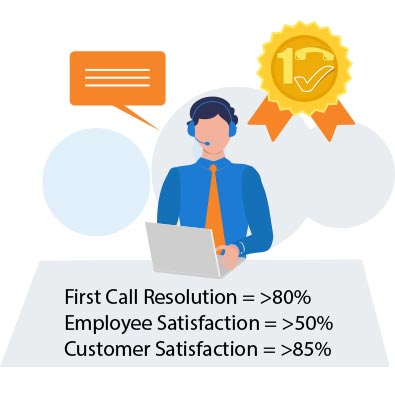Learn from the Best Call Centers
It has been SQM’s experience that, in many cases, when you benchmark against a call center within your industry that is not a 1st quartile customer servicer performer, you tend to come away with small improvement ideas on people, processes, and technology practices. This occurs because the awareness of what your direct competitors are doing within your direct industry tends to be fairly high. However, significant customer service improvement ideas for people, processes, and technology are more likely to come from learning from the best call centers for delivering great customer service. In most cases, they come from industries outside your specific industry.
For improving customer service, a best practice is to learn from call centers that have achieved key performance indicators (KPI) such as >80% First Call Resolution (FCR), >50% Employee Satisfaction (Esat) top box survey response, and >85% Customer Satisfaction (Csat) top box survey response) performance. As a result, of achieving the KPIs, these call centers have a proven track record for achieving effective people, process, and technology practices to achieve world-class customer service performance. Unfortunately, only 5% of call centers in North America can achieve FCR, Esat, and Csat world-class KPIs standards.

Furthermore, the FCR, Esat, and Csat performance of world class call centers tend to be a more accurate reflection of what world-class call center customer service should look like. SQM has met many call center managers who say that they have best practices for people, processes, and technology. However, we found out that their assessments were not accurate by conducting employee and customer surveys to determine their FCR, Csat, and Esat performance in many cases.
To determine world-class customer service, SQM has more confidence in customers who use the call center and agents working in the call center than a manager who has never surveyed their customers or employees to determine customer service. Unfortunately, in some cases, call center managers tend to exaggerate their call center performance.
Furthermore, customers do not typically benchmark you for customer service based on an industry comparison (e.g., company healthcare call center versus another company healthcare call center). Instead, they judge you based on their best call center customer service, which, in most cases, comes from a different industry.
Traditional benchmarking practices compare you within your industry and for similar types of calls to benchmark your customer service performance fairly. SQM believes this to be good practice; however, we believe that benchmarking against world-class call centers from all industries is a best practice.

Benchmarking Call Center Performance
Do you know who the best FCR, Esat, and Csat performers are in your company and inside or outside your industry? SQM is often asked who performs the best in specific industries such as telecommunications, health care, retail, financial, energy, or insurance. Unfortunately, most call centers do not know how their direct or indirect competitors perform concerning FCR, Esat, or Csat metrics.
It is vital to evaluate the differences for FCR or call resolution and Csat performance versus just using traditional operational metrics’ performance. At SQM, we have found that this evaluation process creates a new paradigm for determining the best agent and supervisor performers due to now using FCR or call resolution and Csat data as part of the evaluation exercise.
It is not uncommon for a discussion to take place on what is more important, customer metrics (i.e., FCR and Csat) or operational metrics (e.g., QA scores, productivity, sales, schedule adherence), when ranking agents’ and supervisors’ performance.
Most world-class customer service performing call center senior managers place a higher value on the customer metrics than on the traditional operational metrics, which is difficult for many managers to do. As difficult as it may be, sharing your ranking of supervisors’ and agents’ FCR and Csat performance with all employees is one of the best practices for learning and improving individual and call center results.
Telling an agent that they are ranked 14th out of 15 agents on their team for their call resolution and Csat performance will, in many cases, motivate them to learn more about how they can improve their ranking position. When ranking agents, it is vital that sample sizes are large enough to provide valid findings. At the agent level, SQM recommends that no less than 15 attributed (to the agent) surveys (five surveys per month) be used to determine the ranking. You can use a three-month rolling average, which allows you to report out every month. Furthermore, it is highly recommended to have lower-performing agents learn how to improve from the best Csat performance agents.
Supervisors and agents with high rankings are motivated to learn more and stay on or near the top, especially when they believe senior managers view the rankings as an important way to identify who does the best job. Therefore, while most supervisors and agents will share their ranking with their peers on their own accord, others would rather not. Sharing the rankings within the team with identifying names is not a common practice, but in some cases, it can be helpful. However, this is a highly controversial practice, one that many managers would disagree with sharing ranking reports at the supervisor and agent level for Csat performance.
There tends to be a general alignment between managers’ Esat and Csat ranking performance. When a very low correlation is seen, it tends to be because call complexity is very low. Conversely, when there is high call complexity, the relationship between Esat rankings and Csat rankings tends to be highly aligned. For example, if a manager ranked first or near the top of the Esat ranking list, there would typically be a similar Csat ranking performance.
The bottom line is that ranking agents and supervisors for their FCR and Csat performance is an opportunity to create more accountability and recognition for their performance and a proven best practice to identify learning opportunities for quick Csat wins (1% to 5% improvement).
Quick Related Links
First Call Resolution Definition First Call Resolution PPT First Call Resolution Benefits
First Call Resolution Strategies First Call Resolution Video Helpdesk First Call Resolution Ranking Agents for Customer Service What is a Good FCR Rate? Best Versus Worst Agents FCR Measurement Case Study Good to Great Service
